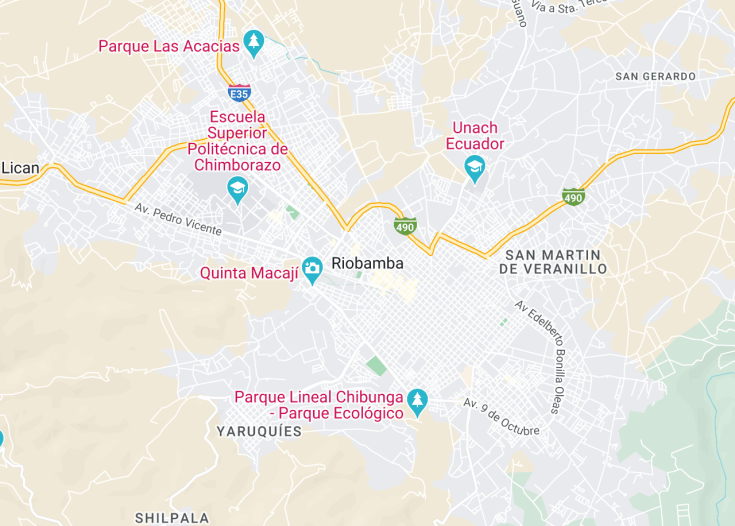Riobamba, nestled in the central highlands of Ecuador, presents a harmonious blend of rich history, captivating landscapes, and vibrant indigenous cultures. Renowned as the starting point for the famed Nariz del Diablo train ride, its surroundings include the majestic Chimborazo volcano, the highest peak in Ecuador. The city itself, often referred to as the “Sultan of the Andes,” offers a unique glimpse into Andean life with its bustling markets, colonial architecture, and friendly locals, making it an essential stop for any cultural enthusiast or adventure seeker exploring Ecuador.
When visiting Riobamba, dress in layers. The weather can fluctuate dramatically, from chilly mornings to warmer afternoons, ensuring you’re comfortable while exploring the city and surrounding areas.
To truly appreciate Riobamba, allocate time for a market visit. The markets are brimming with local crafts and produce, providing a genuine taste of the city’s culture and daily life.
Top things to do & see in Riobamba
Select the following sights and activities to discover best tickets and tours available in Riobamba.
Riobamba: The Heart of the Andes
| Country | Ecuador |
| Time in Riobamba | GMT-5 |
| Language spoken | Spanish |
| Population | 259,678 (source: Ecuador’s National Statistics Institute) |
| Currency | Ecuadorian sucre (Symbol: S/. Code: ECS) |
| Airports |
|
Riobamba, located in the central part of Ecuador, carries a rich blend of history and culture, framed by the majestic Andes mountains. This city, known for its colonial architecture and cobbled streets, provides a snapshot of Ecuador’s complex past and vibrant present. Historically, it was the first city in Ecuador to have a constitution and played a pivotal role during the Ecuadorian War of Independence.
Home to the oldest railway in the country, Riobamba serves as a gateway to the stunning Chimborazo volcano, the highest point in Ecuador. This city offers a unique mixture of outdoor activities and cultural experiences, including the famed “Nariz del Diablo” train ride, which offers breathtaking views and a steep descent into the river gorge.
Riobamba also hosts vibrant markets showcasing indigenous crafts, textiles, and jewelry. Among these, the Mercado de la Merced stands out as a hotspot for locals and tourists alike, offering fresh produce and traditional Ecuadorian cuisine. The city’s food scene is renowned for its variety, including the famous hornado (roasted pork), which is celebrated in annual culinary festivals.
Culturally, Riobamba is significant. It witnesses the colorful Fiesta de San Pedro every June, reflecting the rich indigenous and mestizo traditions through music, dance, and fireworks. The city’s cultural tapestry is further enriched by its museums, including the Museum of the City, which narrates the tale of Riobamba through artifacts and displays.
Where is Riobamba?
Riobamba is nestled in the Chambo River Valley of the Andes mountain range, central Ecuador.
Distances:
| Route | Distance by car | Time by car |
|---|---|---|
| Quito to Riobamba | 137 miles | 3.5 hours |
| Guayaquil to Riobamba | 155 miles | 3.75 hours |
| Cuenca to Riobamba | 198 miles | 4.25 hours |
| Ambato to Riobamba | 30 miles | 1 hour |
What is Riobamba famous for?
Riobamba is renowned for its proximity to Chimborazo Volcano, the highest peak in Ecuador, and for hosting one of the most challenging segments of the Trans-Andean railroad.
History
Pre-Hispanic Era (Before 1534)
Riobamba, located in the central Andean region of Ecuador, boasts a rich tapestry of historical significance rooted in its indigenous cultures. The area was originally inhabited by the Puruhá people, a tribe that thrived in harmony with the Andean landscapes before the arrival of the Incas. The Puruhás were known for their resilient socio-political structures and successful agricultural practices which were integral to their culture and survival.
Colonial Period (1534-1820)
The foundation of Riobamba dates back to 1534, during the Spanish conquest of the Inca Empire. It was re-established in its current location in 1537 after an earthquake destroyed the initial city. This period marked significant transformations as the city became an important colonial hub, characterized by the construction of majestic churches, public buildings, and the influence of Spanish culture and governance on the local population.
Republican Era (1820-Present)
Following Ecuador’s independence in 1820, Riobamba played a pivotal role in the new republic’s development. It is historically significant as the place where the first Ecuadorian constitution was drafted in 1830. The city has since evolved, preserving its rich historical heritage while integrating modern advancements. Present-day Riobamba is a reflection of its vibrant history, combining colonial architecture with contemporary Ecuadorian life.
Visit Riobamba
Attractions in Riobamba
Riobamba offers a unique blend of natural beauty, historic architecture, and vibrant culture. Key attractions include:
- Chimborazo Volcano: As the highest peak in Ecuador, it presents a challenging yet rewarding hiking experience with stunning panoramic views.
- Sangay National Park: A biodiversity hotspot that is ideal for nature enthusiasts.
- The Cathedral of Riobamba: Known for its intricate design and historical significance.
- Market of Saturday: A bustling market that showcases the rich cultural tapestry of the region through crafts, foods, and textiles.
Cultural Festivities in Riobamba
Riobamba is renowned for its vibrant cultural scene, particularly during the “Fiesta de Riobamba” held in April, celebrating the city’s foundation with parades, music, and traditional dances.
Best time to visit Riobamba
The optimal time to visit Riobamba is between June and September, when the weather is generally drier, providing clearer views of the surrounding Andean peaks and making outdoor activities more enjoyable.
Is Riobamba worth visiting?
Riobamba is undoubtedly worth visiting for those who appreciate a blend of natural beauty, historical depth, and cultural richness. The city offers a unique window into the past and present of Ecuador, framed by the stunning backdrop of the Andes. Whether you’re exploring its historic streets, hiking its imposing peaks, or participating in its lively festivals, Riobamba offers a compelling experience that resonates with both adventure seekers and cultural enthusiasts alike.










